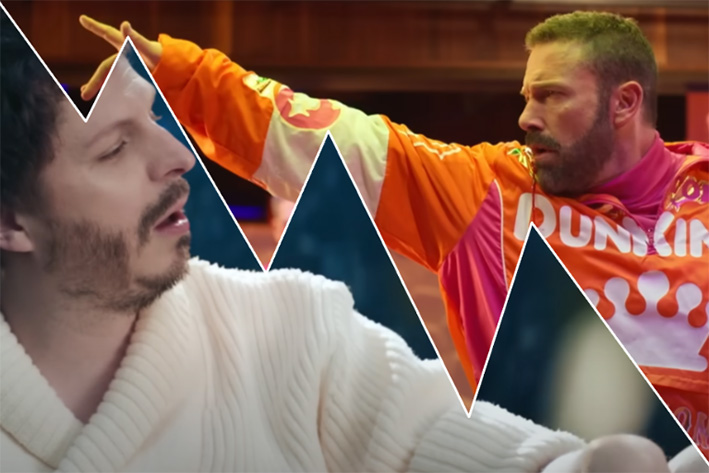4 key learnings when we tested Super Bowl ads on TikTok

Opinion
For brands looking to be seen and heard during tentpole events in 2024, here are our tips for ‘crossing the streams’ in successful TV+TikTok campaigns.
The Super Bowl may be long gone, but there were a lot of key lessons for brands on how to land big moments at other tentpole events across both TV and social — or “cross the streams”, if you will. Look out for a continuation of that Ghostbusters analogy later.
I was a social media guy and I’ve done a lot of “war rooms” — or “huddle hut”, for the purposes of these Super Bowl learnings. I once persuaded people at Number 10 to give us the keys to the @GREATBritain account to live-tweet the Brits and, weekly, we’d pull up with beers to live-tweet The Voice from the official account. One night, with client sign-off, we even told Katie Hopkins to “shut your face”. Hat Tip to David Levin for one of the best moments of my career.
The reason I mention this is because it gave me a unique view on a recent study we conducted at Daivid, testing the most (and least) effective Super Bowl brands on both TV and TikTok. I stayed up until 4am in my “huddle hut” and logged every ad on TV to make sure we’d picked up everything Super Bowly from those same advertisers on TikTok.
We then measured how almost 5,000 US respondents felt while watching both the TV and TikTok content using a combination of facial-coding technology, eye-tracking and survey responses.
Why TikTok and TV?
First, and most importantly, creative effectiveness does not live on one channel. It’s the combined effect of wherever that campaign reaches consumers. Hence the decision to test across both TV and social.
We decided against looking at X because it’s turned into a fight at the raccoon sanctuary — something that advertisers underlined with 55% less social companion spend this year. TikTok is the fastest-growing channel in the US, so it was the best place to see what the big brands would do.
So, for any brands looking to be heard across TV and TikTok at the Olympics, the Euros, Eurovision or any tentpole event this year and beyond, here are four data-led learnings we took from the big game.
In for a cent, in for a buck
Paramount+ was the second most effective Super Bowl brand on TikTok — according to our research, which looked at how well content generated attention, positive emotions and brand uplifts — because it went to the effort of creating bespoke social assets from “content in the can”, not just edits.
They were slick, too, heroing characters from the TV commercial who hadn’t had much precious airtime during the big game. So, as our friends at Warc know, by committing to the creative idea across different channels, brands can drive greater effectiveness.
Tell the whole story
Sometimes kids launch into a story, leaving out important parts that they’ve already said in their heads. We saw this with shorter social edits of TV ads in many of the lower-performing brands on TikTok.
Brands must be really careful, as a slipshod social edit could cut out the parts that generate the highest levels of attention and strongest emotional responses — the key drivers of memory and effectiveness. Notably, of the 51 TikTok brands we tested, 12 of the lowest 25 had “confusion” as the main negative emotion. Meanwhile, in the top 26, it only appeared twice.
For brands looking to maximise their TikTok effectiveness, it’s worth putting the whole piece up rather than some crappy edit, shot for vertical or letterboxed so a non-TV exposed audience knows what’s going on. Confusion is the effectiveness killer.
Tease, trend, extend
The Super Bowl charges advertisers $7m for 30 seconds. TikTok doesn’t. You can use it as much as you want. Use it to build hype before an event, trend in real time and extend the conversation afterwards.
This maximises the effectiveness of the campaign — without breaking your budget. Dunkin’ came third in our TikTok chart because of this. By mid-February, there had been no fewer than 14 edits and continuations of the campaign story on TikTok, including the ability to buy those tracksuits.
It’s the (creator) economy, stupid
It’s a bit obvious, but what do you find on TikTok? Creators. Lots of them. They create not just the content but the culture of the platform. Just sticking up the TV ad has strong “how do you do, fellow kids” energy.
Our winner on TikTok was the glorious CeraVe campaign. It had skincare and beauty influencers in on the joke, not just to tease and trend, but to make it funnier for everyone.
The return of the clumsy Ghostbusters analogy
So, like the lumbering Stay Puft Marshmallow Man, here is the conclusion I felt about the TV + TikTok experience at 4am that Monday morning.
The Ghostbusters were always worried about crossing the streams. Admittedly, they were worried about “total protonic reversal” and I’m talking about siloed media, but don’t let that hinder a good analogy.
Brands that crossed the streams showed an understanding of what TikTok does, rather than seeing it as a side plate for a TV dinner. They were the ones that won. Just a slight diversion of effort and a bit of pre-planning made their efforts shine, just as it can for you.
 Barney Worfolk-Smith is co-founder of Daivid
Barney Worfolk-Smith is co-founder of Daivid



